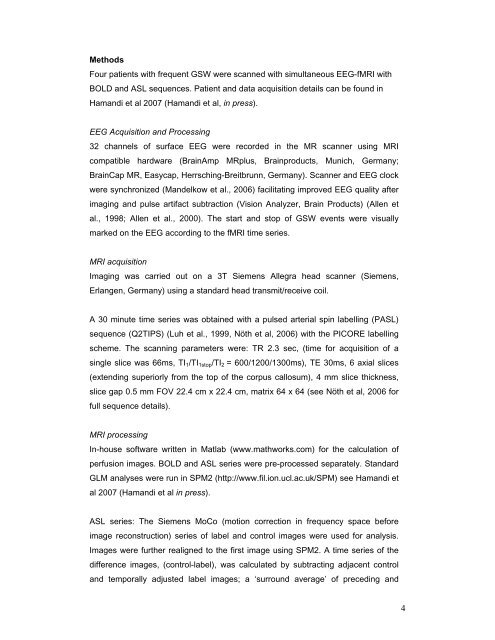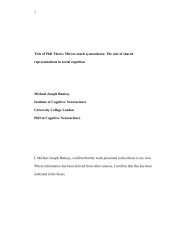An investigation of the relationship between BOLD and perfusion ...
An investigation of the relationship between BOLD and perfusion ...
An investigation of the relationship between BOLD and perfusion ...
You also want an ePaper? Increase the reach of your titles
YUMPU automatically turns print PDFs into web optimized ePapers that Google loves.
Methods<br />
Four patients with frequent GSW were scanned with simultaneous EEG-fMRI with<br />
<strong>BOLD</strong> <strong>and</strong> ASL sequences. Patient <strong>and</strong> data acquisition details can be found in<br />
Ham<strong>and</strong>i et al 2007 (Ham<strong>and</strong>i et al, in press).<br />
EEG Acquisition <strong>and</strong> Processing<br />
32 channels <strong>of</strong> surface EEG were recorded in <strong>the</strong> MR scanner using MRI<br />
compatible hardware (BrainAmp MRplus, Brainproducts, Munich, Germany;<br />
BrainCap MR, Easycap, Herrsching-Breitbrunn, Germany). Scanner <strong>and</strong> EEG clock<br />
were synchronized (M<strong>and</strong>elkow et al., 2006) facilitating improved EEG quality after<br />
imaging <strong>and</strong> pulse artifact subtraction (Vision <strong>An</strong>alyzer, Brain Products) (Allen et<br />
al., 1998; Allen et al., 2000). The start <strong>and</strong> stop <strong>of</strong> GSW events were visually<br />
marked on <strong>the</strong> EEG according to <strong>the</strong> fMRI time series.<br />
MRI acquisition<br />
Imaging was carried out on a 3T Siemens Allegra head scanner (Siemens,<br />
Erlangen, Germany) using a st<strong>and</strong>ard head transmit/receive coil.<br />
A 30 minute time series was obtained with a pulsed arterial spin labelling (PASL)<br />
sequence (Q2TIPS) (Luh et al., 1999, Nöth et al, 2006) with <strong>the</strong> PICORE labelling<br />
scheme. The scanning parameters were: TR 2.3 sec, (time for acquisition <strong>of</strong> a<br />
single slice was 66ms, TI1/TI1stop/TI2 = 600/1200/1300ms), TE 30ms, 6 axial slices<br />
(extending superiorly from <strong>the</strong> top <strong>of</strong> <strong>the</strong> corpus callosum), 4 mm slice thickness,<br />
slice gap 0.5 mm FOV 22.4 cm x 22.4 cm, matrix 64 x 64 (see Nöth et al, 2006 for<br />
full sequence details).<br />
MRI processing<br />
In-house s<strong>of</strong>tware written in Matlab (www.mathworks.com) for <strong>the</strong> calculation <strong>of</strong><br />
<strong>perfusion</strong> images. <strong>BOLD</strong> <strong>and</strong> ASL series were pre-processed separately. St<strong>and</strong>ard<br />
GLM analyses were run in SPM2 (http://www.fil.ion.ucl.ac.uk/SPM) see Ham<strong>and</strong>i et<br />
al 2007 (Ham<strong>and</strong>i et al in press).<br />
ASL series: The Siemens MoCo (motion correction in frequency space before<br />
image reconstruction) series <strong>of</strong> label <strong>and</strong> control images were used for analysis.<br />
Images were fur<strong>the</strong>r realigned to <strong>the</strong> first image using SPM2. A time series <strong>of</strong> <strong>the</strong><br />
difference images, (control-label), was calculated by subtracting adjacent control<br />
<strong>and</strong> temporally adjusted label images; a ‘surround average’ <strong>of</strong> preceding <strong>and</strong><br />
4

















